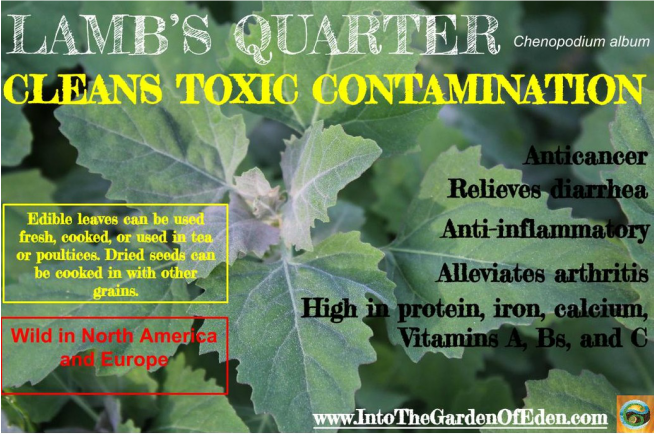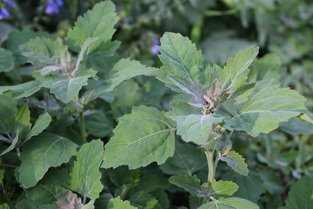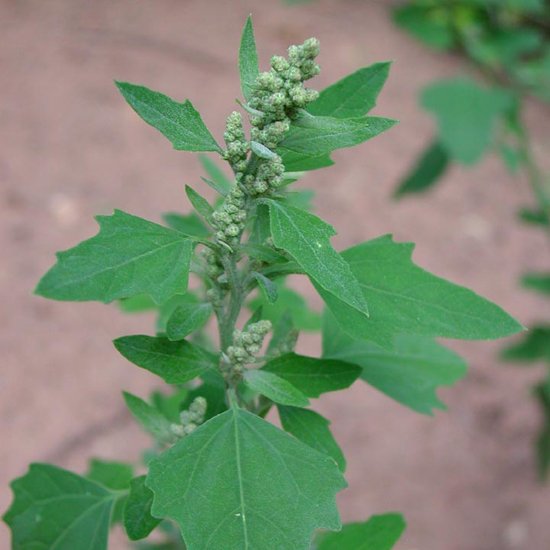Every aspect of life is better when you feel good and healthy!
To that end, we offer a wealth of information on the super natural healing powers of plants, herbs, and common "weeds". Nature itself crafts the best medicine. We seek to reacquaint you with our roots and reintroduce these incredible plants to your diet and medicine chest. Whether you take this info with you into the garden or wilderness, or you choose to order our beyond organic, super sustainable tea blends (or both!), we wish you happy healing.
We present more wildcrafted medicine that is often dishonored as an invasive weed: lamb's quarter! This is a super nutritious plant that's great for foragers to add to their repertoire.

Lamb's quarter leaves are shaped like little webbed feet, hence its alternate name goosefoot. It grows upright to be about 3 feet tall with alternate leaves. It sometimes has a powder coating or develops fuchsia colored spots; both are totally normal, and the plant is still edible. The powder is actually pollen. If you find it gritty or unpalatable, just rinse well before consuming! Leaves are soft and supple. Upper leaves may be smooth-edged, and lower leaves are usually serrated.
Lamb's quarter grows very easily. It sucks up minerals and contaminants (especially nitrates) from the soil like a champ, but plants grown in contaminated or pesticide-treated soils should not be consumed because the toxins are then concentrated in the plant. [1]
Lamb's quarter grows prolifically all over our property! We regularly pick the leaves from the woody stems for raw salads and green juice; it's one of the favorite greens of the Eden Knights. The flavor is slightly reminiscent of avocado. The seeds can be consumed whole or ground into flour, and the leaves can be stirred into soups or stir fry too!
Lamb's quarter is related to quinoa. It's high in protein and calcium and a slew of other valuable nutrients. In fact, it's said that lamb's quarter is second only to amaranth as far as nutritious plants go. It's also high in saponins and oxalic acid, so be warned if you have kidney conditions, although oxalic acid content can be counteracted by cooking it with a source of calcium, like cheese or other dairy.
If the plant or its seeds smells like turpentines, do not consume it! That's actually a poisonous look alike to be avoided.

Lamb's Quarter Healing Powers:
- relieves stomach aches
- prevents scurvy
- relieves arthritis pain
- external poultice treats burns and wounds
- high in vitamins & minerals
- antibacterial
- antiviral
- anti-inflammatory
- alleviates diarrhea
- detoxes soil
- blocks breast cancer cell development [5]

We have a lovely recipe for a quick lamb's quarter sautée: Sizzle a few cloves of garlic with chopped onion in a bit of olive oil. Add handfuls of lamb's quarter leaves stripped off the stalk; stir for 30 seconds or so. Remove from heat, and add salt and pepper and lemon juice.
Sources:
[1] Ebrahimi, Mahdieh. Enhanced Phytoremediation Capacity of Chenopodium Album L. Grown on Pb-Contaminated Soils Using EDTA Reduction of Leaching Risk. Soil And Sediment Contamination: An International Journal. (2016) 25:6.
[2] Lambs Quarter. http://www.digherbs.com/lambs-quarter.html
[3] Lambs Quarter. http://wildblessings.com/plants/lambs-quarter/
[4] Weed, Susun. Lamb's Quarters -- Chenopodium album. 2013.
[5] Robinson, Jo. Eating on the Wild Side: The Missing Link to Optimum Health. Little, Brown and Company: New York, 2013.
www.intothegardenofeden.com

